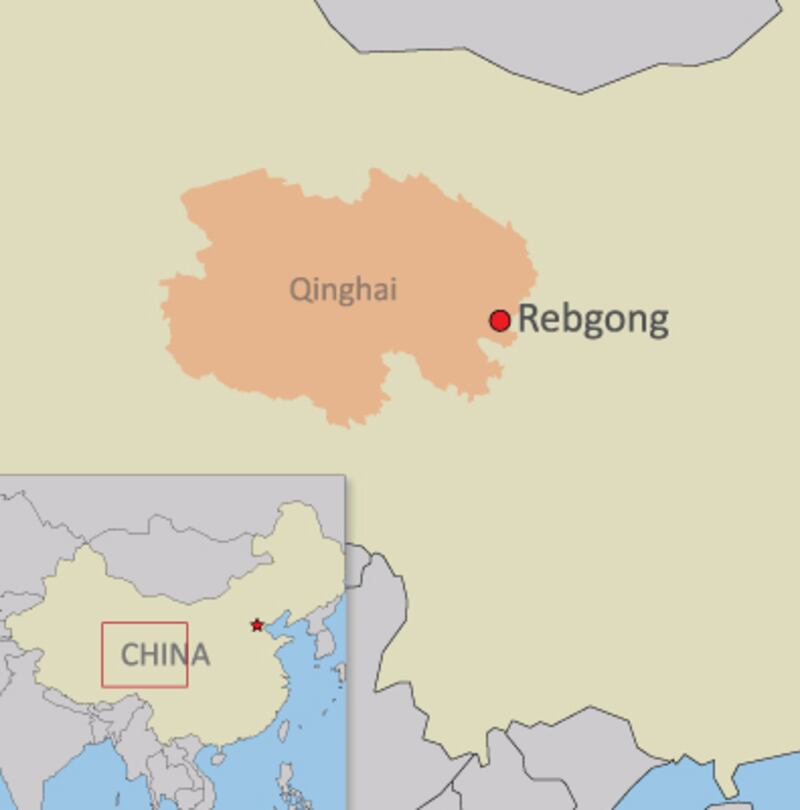Updated at 5.20 p.m. EST on 2012-11-4
Thousands of Tibetans staged protests against Chinese rule after another self-immolation death Sunday in a Tibetan-populated area in Qinghai province, triggering a massive security buildup, according to sources.
Traditional artist Dorjee Lhundup, 25, shouted slogans against Chinese rule and called for the return of Tibet's spiritual leader the Dalai Lama before burning himself to death in Rongwo township, the capital of Rebgong (in Chinese, Tongren) county in the Malho (Huangnan) Tibetan Autonomous Prefecture, the sources said.
The dawn self-immolation attracted a large crowd of monks and residents to the township, with many of them placing the "khata," the traditional Tibetan scarf, on his charred remains as a mark of respect for the father of two, one source said.
Later, several thousand Tibetans converged at a hill site near the key Rongwo monastery as Dorjee Lhundup's body was taken there for prayers and immediate cremation to prevent the Chinese authorities from interfering with funeral rites, the source said.
“People shouted 'Ki! Ki!,' a Tibetan battle cry, and others raised slogans at the Dhongya-la cremation site where thousands of people gathered to mourn and pay their respect for the deceased and stand in solidarity with the family of Dorjee Lhundup,” the source said.
His family members pleaded with the crowd to end the protest for fear over their safety, saying Dorjee Lhundup set fire to himself to "protect Tibet's interest" and underscore demands for the return of the Dalai Lama, who has been living in exile in India since 1959 following a failed Tibetan uprising against Chinese rule.
“Soon after the self immolation incident, security forces poured into the town and patrolled the streets and the situation was tense," according to the source.
There were no arrests but, according to eyewitnesses cited by sources, security officials warned the Tibetans against spreading the news of the self-immolation, the 63rd since the wave of fiery protests began in February 2009.
Frightened
The Dhongya-la site was where two other Tibetan self-immolators in Rongwo were also cremated earlier this year. Those self-immolations in March had sparked the largest protests in Tibet since deadly riots in the region in 2008.
"Tibetans in the town say that they are frightened to go out, reporting large numbers of security forces on the streets and restrictions on movements in the town. Internet and mobile communications are being interrupted to prevent the spread of information," London-based advocacy group Free Tibet said in a statement.
Free Tibet Director Stephanie Brigden said more than half of the Tibetans who torched themselves have only known a Tibet under Chinese occupation "and still they reject Chinese rule."
“China's policies in Tibet have failed. Protests in Tibet are escalating ahead of the change of leadership," she said as Beijing prepares for a once-in-a decade transition to be endorsed at the18th ruling Chinese Communist Party Congress beginning on Thursday.
“Events inside Tibet expose how the 'One China' policy has failed. The next generation of Communist Party leaders must seize the opportunity to take a different approach from one which tries to impose stability by force,” Brigden said.
Rebgong was the scene of constant student protests in October 2010 against a proposed change in the language of instruction in schools from Tibetan to Chinese.
Rare UN call

Sunday's self-immolation came three days after U.N. High Commissioner for Human Rights Navi Pillay called on China to address the grievances of Tibetans and sought an end to the self-immolation protests.
“I recognize Tibetans’ intense sense of frustration and despair which has led them to resort to such extreme means, but there are other ways to make those feelings clear,” she said.
In her statement, believed to be among the most forceful by a top U.N. official in directly addressing the situation in Tibet, Pillay pointed to “reports of detentions and disappearances, of excessive use of force against peaceful demonstrators, and curbs on the cultural rights of Tibetans.”
“I call on [China’s] government to respect the rights to peaceful assembly and expression, and to release all individuals detained for merely exercising these universal rights,” she said.
Cases cited by Pillay include the beating and imprisonment of a 17-year-old Tibetan girl who distributed flyers calling for Tibetan freedom and the return of the Dalai Lama, along with other instances of Tibetans jailed for writing essays, making films, or sending information about events in Tibet to contacts outside the region.
Media access to Tibetan areas should be lifted, Pillay said, and “independent and impartial” monitors allowed to visit and report on the conditions they observe.
In addition, Pillay called on China to suspend the forced resettlement of Tibetan nomads and to review policies encouraging large-scale Han Chinese migration into ethnic Tibetan areas.
Reported by Palden Gyal for RFA's Tibetan service. Translated by Dorjee Damdul. Written in English by Parameswaran Ponnudurai.
CORRECTION: An earlier version of the report had the self-immolator's name spelt as Dorje Dhondup, and mentioned that the Dalai Lama has been living in exile in India since 1958.
